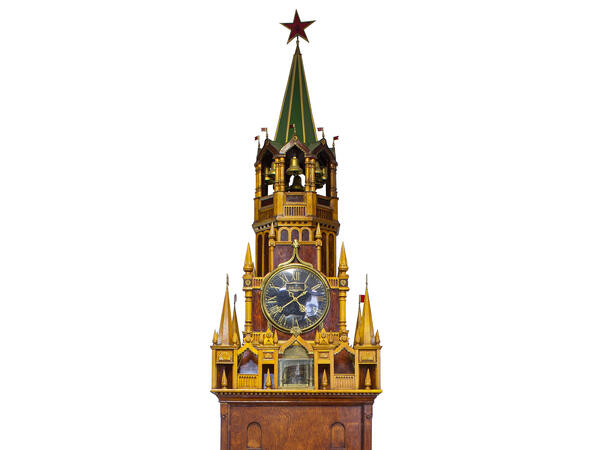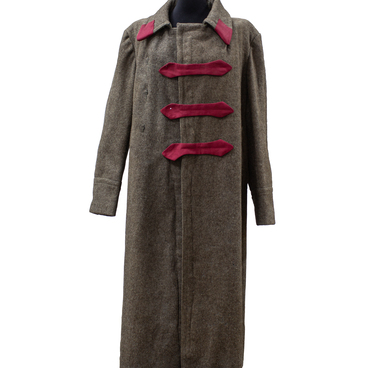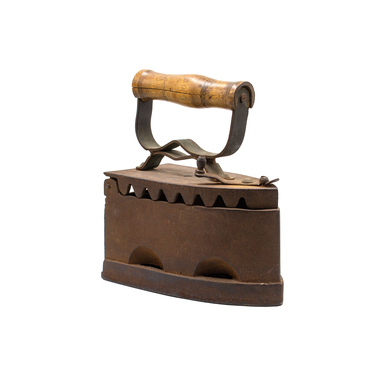The model of the Spasskaya Tower of the Moscow Kremlin was made by Kotovsk craftsman Ivan Kozadayev. The clocktower consists of five thousand parts and is an exact copy of the Kremlin chimes. All the internal mechanisms were made of metal, and the body was carved out of wood. The bells in the upper part of the model were commissioned by the craftsman to be cast at the Tambov Gunpowder Factory. The center of the composition features a chiming clock and an opening window. Every 20 minutes, when the chimes strike, the red star lights up at the top of the tower.
Before the war, Ivan Kozadayev collected old silver weight clocks. His collection even included genuine Omega Swiss watches and the ones produced by the famous St. Petersburg watch company Paul Buhre. At one point, Kozadayev decided to add a clock made with his own hands to the collection. In the late 1940s, he worked in the instrumentation workshop at the Plastmass Plant in Kotovsk, where he mastered watchmaking.
The idea of developing a model of the chimes came to Kozadayev in 1947. He was inspired by his trip to Moscow, where he saw the Spasskaya Tower for the first time in his life. Kozadayev made up his mind on making the exact copy of it in the workshop. For this purpose, he bought several sets of themed postcards, which depicted the tower from every conceivable angle. He used the photographs to make a reduced one-meter-high copy of the chimes. That model was kept in the craftsman’s family for some time but has not survived to this day.
After this attempt, Kozadayev set to work on a larger scale. The base for the tower was carved from alder and birch. Kozadayev also worked as a handicraft teacher at that time, and he used the school machine tools to make all small parts, gears, and screws for the interior structure and clockwork. The model was finished only by 1953.
Later on, the craftsman continued to improve the design by adding new elements to it from time to time. For example, in order to create polyphonic chimes, he chose bells that were tuned to the same key. Kozadayev intended for them to sound simultaneously. He completely disassembled the clockwork but unfortunately could not finish the job because of his illness, which soon led to his death.
A few years later, the clock was assembled by the craftsman’s grandson Igor Yefimov. He donated the item to the museum — this was Kozadayev’s request shortly before his death.
Before the war, Ivan Kozadayev collected old silver weight clocks. His collection even included genuine Omega Swiss watches and the ones produced by the famous St. Petersburg watch company Paul Buhre. At one point, Kozadayev decided to add a clock made with his own hands to the collection. In the late 1940s, he worked in the instrumentation workshop at the Plastmass Plant in Kotovsk, where he mastered watchmaking.
The idea of developing a model of the chimes came to Kozadayev in 1947. He was inspired by his trip to Moscow, where he saw the Spasskaya Tower for the first time in his life. Kozadayev made up his mind on making the exact copy of it in the workshop. For this purpose, he bought several sets of themed postcards, which depicted the tower from every conceivable angle. He used the photographs to make a reduced one-meter-high copy of the chimes. That model was kept in the craftsman’s family for some time but has not survived to this day.
After this attempt, Kozadayev set to work on a larger scale. The base for the tower was carved from alder and birch. Kozadayev also worked as a handicraft teacher at that time, and he used the school machine tools to make all small parts, gears, and screws for the interior structure and clockwork. The model was finished only by 1953.
Later on, the craftsman continued to improve the design by adding new elements to it from time to time. For example, in order to create polyphonic chimes, he chose bells that were tuned to the same key. Kozadayev intended for them to sound simultaneously. He completely disassembled the clockwork but unfortunately could not finish the job because of his illness, which soon led to his death.
A few years later, the clock was assembled by the craftsman’s grandson Igor Yefimov. He donated the item to the museum — this was Kozadayev’s request shortly before his death.



